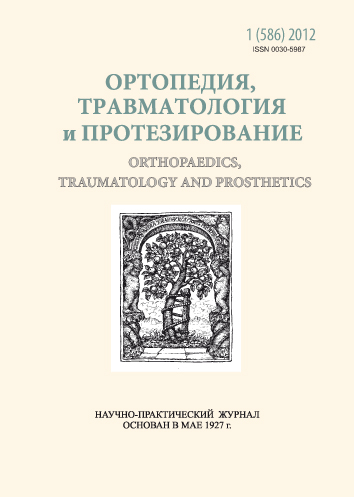Influence of Bivalos on reparative regeneration of the bone tissue: data of experimental and clinical studies
DOI:
https://doi.org/10.15674/0030-5987201215-11Keywords:
strontium ranelate, bone fractures, reparative regenerationAbstract
The article describes modern points of view on processes of reparative regeneration at norm and in pathology, as well as on the effects, produced by different local and systemic agents on the course of fracture consolidation phases. Also, there are data of experimental studies, which demonstrate the positive effects of Bivalos on enlargement of calluses, improvement of biomechanical properties of bones and microarchitectonics of the osseous tissues, acceleration of fracture consolidation rates and implant osteointegration. The analysis of data of clinical observations revealed acceleration of fracture consolidation terms and improvement in the state of patients at different age owing to Bivalos. The article contains information about current randomized placebo-controlled studies of the role of Bivalos in patients after endoprosthesis replacement and in affection of bone fracture consolidation.References
- Корж Н.А. Репаративная регенерация кости: современный взгляд на проблему. Локальные факторы, влияющие на заживление перелома (сообщение 4) / Н.А. Корж, Л.Д. Горидова, К.К. Романенко // Ортопед. травматол. — 2006. — № 2. — С. 99–106.
- Корж Н.А. Репаративная регенерация кости: современный взгляд на проблему. Системные факторы, влияющие на заживление перелома (сообщение 3) / Н.А. Корж, Н.В. Дедух, О.А. Никольченко // Ортопед. травматол. — 2006. — № 2. — С. 93–99.
- Possible benefits of strontium ranelate in complicated long bone fractures / D.N. Alegre, С. Ribeiro, С. Sousa et al. // Rheumatol. Int. — 2012. — Vol. 32. — P. 439–443.
- Alegre D.N. Clinical experience of fracture healing / D.N. Alegre // OsteoOpinion. — 2010. — Vol. 6, № 17. — P. 2–3.
- Enhancement of experimental fracture-healing by systemic administration of recombinant human parathyroid hormone (PTH 1-34) / Y.M. Alkhiary, L.C. Gerstenfeld, E. Krall et al. // J. Bone Joint Surg. — 2005. — Vol. 87-A. — P. 731–741.
- Strontium ranelate enhances callus strength more than PTH 1–34 in an osteoporotic rat model of fracture healing / B. Habermann, K. Kafchitsas, G. Olender et al. // Calcif. Tissue Int. — 2010. — Vol. 86. — P. 82–89.
- Effect of teriparatide [rhPTH (1, 34)] and calcitonin on intertransverse process fusion in a rabbit model / R.A. Lehman Jr., A.E. Dmitriev, M.J. Cardoso et al. // Spine. — 2010. — Vol. 35. — P. 146–152.
- Strontium ranelate treatment enhances hydroxyapatite-coated titanium screws fixation in osteoporotic rats / Y. Li, G. Feng, Y. Gao et al. // J. Orthop. Res. — 2010. — Vol. 28. — P. 578–582.
- Systemic treatment with strontium ranelate promotes tibial fracture healing in ovariectomized rats / Y.F. Li, E. Luo, G. Feng et al. // Osteoporos. Int. — 2010. — Vol. 21. — P. 1889–1897.
- Little D. Biology of fracture healing and effect of osteoporotic therapies / D. Little // Oral presentation at IBMS Davos Workshops Bone Biology& Therapeutics (9-11.03.2008).
- Strontium ranelate improves implant osseointegration / L. Maimoun, T.C. Brennan, I. Badoud et al. // Bone. — 2010. — Vol. 46. — P. 1436–1441.
- Strontium ranelate and femoral fracture healing during rheumatoid arthritis and osteoporosis / S. Salvin, L. Quartuccio, M. Maset et al. // Bone. — 2009. — Vol. 45. — S. 143.
- Parathyroid hormone and bisphosphonate have opposite effects on stress fracture repair / A.V. Sloan, J.R. Martin, S. Li et al. // Bone. — 2010. — Vol. 47. — P. 235–240.
- Strontium ranelate and bone healing: reports of two cases / U. Tarantino, M. Celi, L. Saturnino et al. // Clin. Cases Miner. Bone Metab. — 2010. — Vol. 7. — P. 65–68.
Downloads
How to Cite
Issue
Section
License
Copyright (c) 2014 Vladyslav Povorozniuk, Mykola Korzh, Natalya Grigoryeva, Volodymyr Klimovitskiy

This work is licensed under a Creative Commons Attribution 4.0 International License.
The authors retain the right of authorship of their manuscript and pass the journal the right of the first publication of this article, which automatically become available from the date of publication under the terms of Creative Commons Attribution License, which allows others to freely distribute the published manuscript with mandatory linking to authors of the original research and the first publication of this one in this journal.
Authors have the right to enter into a separate supplemental agreement on the additional non-exclusive distribution of manuscript in the form in which it was published by the journal (i.e. to put work in electronic storage of an institution or publish as a part of the book) while maintaining the reference to the first publication of the manuscript in this journal.
The editorial policy of the journal allows authors and encourages manuscript accommodation online (i.e. in storage of an institution or on the personal websites) as before submission of the manuscript to the editorial office, and during its editorial processing because it contributes to productive scientific discussion and positively affects the efficiency and dynamics of the published manuscript citation (see The Effect of Open Access).














